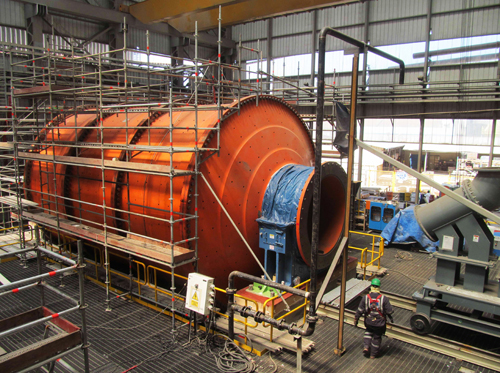
Peru’s rich mining history is well documented, with the roots of what has become a hugely attractive region for the industry dating back centuries. Such a legacy can be seen in the development of the Colquijirca mine, the origins of which pre-date the era of the Incas, when it has been documented that ancient tribes silver mined the surrounding foothills of Puntac-Marca.
Located in the Cerro de Pasco region of the country, the Colquijirca mine, and the adjoining Huaraucaca concentration plant, is today managed by Sociedad Minera El Brocal, a Peru-based company primarily active in the extraction, concentration and commercialisation of polymetallic ores, including zinc, silver, lead and copper.
In addition to the aforementioned activities the company conducts a number of other important operations including the open pit activities at the Tajo Norte mine and the running of the Marcapunta Norte underground mine. Furthermore, Sociedad Minera El Brocal is also engaged in exploration projects currently underway at the Marcapunta Oeste and San Gregorio mines.
At the Tajo Norte mine the company is presently involved in the exploiting of polymetallic mineral content and sulphides consisting mainly of silver, lead, zinc and copper. The Marcapunta Norte mine on the other hand is an underground operation that exploits copper ores consisting mainly of enargite and minor amounts of chalcocite, chalcopyrite, tennantite, luzonita, colusita and bismuthinite, and the bargain includes mainly pyrite, quartz, alunite, kaolinite and clays. Mineralisation is housed in carbonate rocks and clay horizons, and the daily production level at this particular asset is approximately 4,000 tonnes per day.
While important work across all of the aforementioned properties continues unabated, arguably the biggest current undertaking for the company involves the Huaraucaca concentration plant, an industrial facility where the company uses selective floatation processes to achieve the concentration of economic mineralisation from the Marcapunta and Tajo Norte mines, and which currently boasts a treatment capacity level of 10,000 metric tonnes per day.
“It is here,” explains Project Director, Jesus Humberto Montes Chavez, “that we are now developing a hugely ambitious project that will treble the capacity of the plant to a design treatment capacity of 18,000 metric tonnes per day. This represents a massive undertaking on our part and is one where we are focusing the majority of our efforts at present. This project equates to a $420 million investment and is one we hope to bring to a conclusion by the end of 2013.”
While it is by no means immune to the global economic pressures that continue to beset mining companies throughout the world, Sociedad Minera El Brocal does possess the advantage of being the holder and operator of a host of impressive properties, each of which possesses excellent medium-to-long term prospects. In addition to its existing assets the company is also continuing to explore for other opportunities in the areas surrounding its operations. The results of this exploration have so far proven very promising, with the company optimistic that several new developments could be set to take place in very near future.
Being a Peru-based company with Peruvian values, it has always been the case that the concept of social responsibility runs through the heart of everything that Sociedad Minera El Brocal does as a business. Indeed it is the policy of the company that its own pursuit of development always aligns itself with the growth and development of the communities who live and work in the areas surrounding its operations. In working to achieve this it runs a number of social development programmes that benefit neighbouring towns and villages. These programmes fall into vital fields such as health, education, training, sanitation and workforce development, each of which contribute towards providing a better quality of life local inhabitants.
This philosophy also extends to the company’s day-to-day operations where it has put into place specific requirements throughout its engineering design that highlight just how respectful it is of the environment and how conscious it is of its own footprint. One such requirement involves the regulating of all the water used across its operations to ensure sustainable usage is maintained at all times. Specific installations also exist amongst Sociedad Minera El Brocal’s infrastructure, such as sewage treatment plants that make sure that all waste is treated accordingly before leaving its facilities.
“In our role as neighbours we have worked hard to establish good relationships with the local communities that live close to our operations,” Montes states. “One particular community for instance has worked so closely with us over the years that they are today the owners and operators of vital heavy machinery and equipment which we utilise across several of our key projects. We believe that this example also highlights how we are trying to create a legacy that will exist after the mine operations end. By providing the opportunity for communities to develop certain skills and expertise we are helping them to prepare, and be equipped, for whatever new challenges await in the future.”
Speaking of the future, Montes is very much aware of what Sociedad Minera El Brocal needs to do in the short term to remain prosperous and why things look bright for the company as a whole. “We are focusing a great deal at the moment on reducing our costs. While this is never an easy thing to achieve, without doing so I believe we would find ourselves ill-prepared for other challenges that may lie ahead. It is therefore vital that we find ways of decreasing our unit consumption levels. Nevertheless, from an operational perspective we remain in a very good place, operating as we are with reserves that have set us up for the long-term and within an area rich in mineral prospects and potential.”
Written by Will Daynes, research by Abi Abagun



 MineraElBrocal-AM-Mining-Nov13-Bro-s.pdf
MineraElBrocal-AM-Mining-Nov13-Bro-s.pdf









